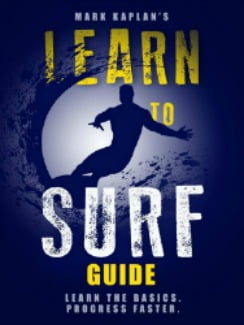Surf timing for catching real waves is important for intermediates advancing from riding foam waves. Learning the timing of real waves requires practice, watching surfers and watching videos.
Improving wave catching ability in surfing is a life time pursuit. Once a person learns to surf, mastering the art of catching all kinds of waves is the challenge and fun of surfing.

The Timing of Real Waves
A foam wave can be seen for a distance and the surfer just has to start moving before it arrives and before it impacts the surf board. There are lots of seconds in this process.
A real wave arcs for a few seconds and the surfer has to be in the right position for the wave to roll under the surf board. As the board is pointing down the face, the surfer paddles hard for a few strokes before popping up.
Anticipation of where waves will arc is important. This skill is learned from reading waves and knowing where they are breaking. The line up is usually a good indication of where this occurs. A surfer sees the bump early as the wave begins to form and decides where he has to paddle to intercept the arc.
Positioning for Real Waves
When the surfer sees the bump and wave start to form, he decides if he paddles out, parallel, or in toward the beach. The surfer wants to be in front of the wave and paddling before the wave peaks. He wants the wave to be pushing him before the lip overhead breaks.
Beginners should seek small real waves of two to three feet. They paddle into area where the waves are breaking and can paddle parallel to waves while watching and waiting. This gives them momentum. When the wave starts to arc, they paddle in front and let it rise behind the board. Then they paddle hard and pop up as the wave lip forms overhead and starts to break.
Beginners will probably just ride straight to the beach. The next step is to angle into the pocket so that they stay ahead of the falling lip. They may begin by just driving the pocket. Then they may learn simple maneuvers like cut backs and bottom turns to run up the lip.
Regular practice is important because the first thing that happens with a lack of practice is a loss of timing.
Learn More
My New Surfing Course in an E-Book plus Demo Video or Audio Version
Get the 18 Chapter, 7,500 word Course that can prepare you for a lesson or give you the fundamentals if you are going to try it on your own. 10 years of teaching 350 students a year has given me the insights on the most precise measures you must follow for success. This course is what I teach on the dry land and in water instruction. The Course includes a 15 minute video on my dry land and in water demonstration. Only $4.95
Buy the E-Book and start learning $2.99. Learn to Surf
Buy the Paperback on Amazon $7.95
Get Learn to Surf Course in 29 minute AUDIO. Great prep for a lesson, reviewing after a lesson, learning on your own, refreshing after not having surfed for a while. See Table of Contents. Only $7.95.

For Oceanside Surf Lessons, see the Home Page
See the Post Search Lessons Teach Fundamentals
See the Post Catching Real Surf Waves
See my Dry Land and in Water Demo video
See my other Surf site for more Posts
I have lowered the price of Courses and Books for the lock down price of $2.99
80 page Learn to Surf Book
![Surf Instructions Beginner to Advanced: Learn to Ride Waves by [Kaplan, Mark]](https://images-na.ssl-images-amazon.com/images/I/51HswFtoBQL.jpg)